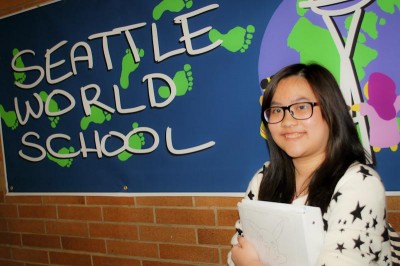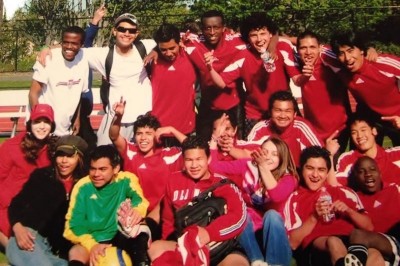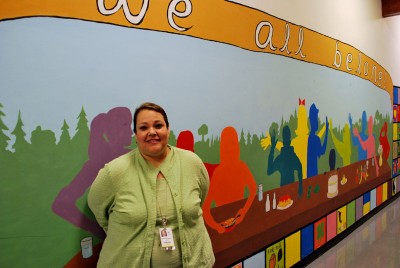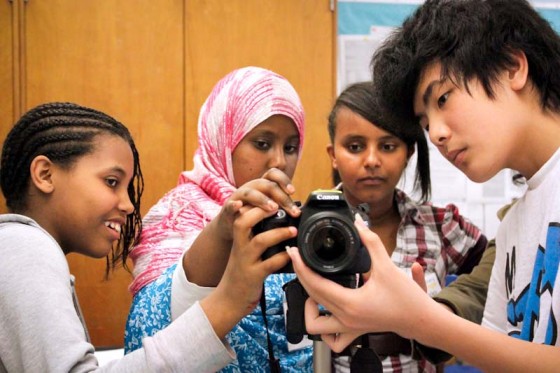The Seattle World School provides a welcoming environment to new students from around the globe. But many struggle to move on to mainstream schools.
¿Como estás? Tôi khỏe. 借过一下. Eímai peinasménos. Bom dia! Who’s the new girl?
Walking through the old wooden doors of the Secondary Bilingual Orientation Center (SBOC) for the first time I heard a barrage of languages. I couldn’t understand any of them.
That first day it was hard to hold back the tears of fear and loneliness with each ringing bell as a new class began and new cultures surrounded me.
But I didn’t feel that way for long.
In just a couple of weeks, I was getting on the yellow bus high-fiving my new friends. We were untied by the two things we all had in common — being recent immigrants, and using English, no matter how broken, as our bridge for communication. It felt like a family.
Nowadays, SBOC has a new building on Capitol Hill, and a new name: the Seattle World School (SWS).
In my day the program offered between one to three semesters of English Language Learner (ELL) classes designed to prepare newly arrived immigrant students to transition to regular high schools. But in 2010 they developed a new option, allowing students to continue at the World School for the remainder of their high school careers if they wanted to.
“For some students two semesters wasn’t enough and they were leaving at a very low level and that was bad,” said Michael McNaul, social sciences teacher at the SWS. “We were sending them off to failure and nothing we could do about it. The high school program helped with that a lot.”

The majority of students still decide to leave the World School in search of the Disney High School Musical experience of mainstream Seattle schools.
But since the high school program started, a number of kids who attempt to transition to Seattle’s regular high schools end up coming right back to SWS.
Jia Ying Tan, a 16 year-old student from China graduated from the ELL program a year ago and transferred to Franklin High School as a freshman. But after just two semesters there, she came back.
Growing up in the countryside of Guang Dong Province in a family of farmers, Tan said she had never had a computer or taken a dance class before coming to the U.S. Those became some of her favorite activities at SWS.
Even though she’s been here for three years and her English is a lot better than she’ll admit, she still felt like an outsider in regular high school.
“In Franklin, there were many students in class and teachers could not take care of them all,” she said. “I didn’t know the classes would be so difficult. I had a video production class and I didn’t know how to use a camera and I got a bad grade. No teacher ever came to help me or tell me what I was doing wrong.”
Coming back to the World School this year, she’s happier. She has teachers who speak her language and are able to help with assignments, and her friends from around the world that are always there for her. The small school with just 231 students, 110 of them in the high school program, is able to accommodate each student’s needs.

Thinking back of my own experience transitioning from the SBOC to Roosevelt High School, I can relate. My English had highly improved, friendships made, and I was sent off to dive into the American culture for the first time. I did well academically, graduating with honors getting accepted to the University of Washington.
But I never felt included.
After four years at Roosevelt, I left with one best friend — who also speaks my native language — and a lot of other acquaintances. But I was never really able to find a connection with native English speakers.
Cynthia Nkeze, ELL teacher at the SWS and a former teacher at Garfield High School, has seen a lot of SWS graduates failing to assimilate.
“[Mainstream schools] need to cultivate a different culture in their students,” she said. “They need to teach American kids to embrace someone who is different from them, someone who doesn’t speak their language or share their culture.”
The SWS website describes the school as “a preliminary educational portal through which immigrant children pass in their quest for academic achievement and full participation in American society.”
But for many students, that’s a transformation that just doesn’t happen in a year or two. Kids with no educational background — or who didn’t have the advantage I did of studying English before they came to the U.S. — have an especially hard time.

Of the 1955 new English Language Learner students who entered the Seattle Public Schools this year, only about ten percent qualified for enrollment in SWS — they have to have arrived in the country within the last year, and demonstrate the highest level of need on the Washington English Language Proficiency Assessment.
But Veronica Maria Gallardo, the Director of the ELL and International Programs Department, says there are hundreds of other ELL students in regular high schools that are falling behind, and would benefit from the smaller class sizes and close knit community at the Seattle World School.
“If I had the high school option when I was there, I would take it,” said Thanh-Thao Truong, a 2006 SBOC graduate and a current UW student. “Not because I’m trying to stay in my comfort zone, but because I want to be near those who’ve always supported me throughout middle school, while also reaching out for new opportunities and skills. That way, I wouldn’t have felt so alone while reaching my goals.”
That supportive environment is exactly what Conice Pedroza, the new principal of SWS this year, wants students to get from her school.
“I want this place to be where [students] can feel that they can learn,” she said. “And whatever goal they set for themselves they know that they can get it here and not fall through the cracks.”



Wonderful article Valeria that’s speaks to the importance of identity and feeling of belonging in a school setting.
Thank you Valeria, its an honor to be a teacher at the Seattle World School!
Thank you Valeria for writing this article from your unique perspective. The World School is a wonderful school. I feel lucky to have found it.
It’s so nice to hear about a successful school in the Seattle Public School system. I wish more people knew about Seattle World School and its amazing educational program and the outstanding accomplishments of its students.
Perhaps the Seattle Times could include an article in the newspaper and at their website.
. In my opinion, this article is a threat to students and their families. It tells students to continue High School at the SWS instead of going to their neighborhood high schools since nobody will help them like the SWS staff do. The example of J. T. who left the SWS for a year, then came back to the SWS because no teachers could speak her language in a regular high school is ridiculous. I suggest that the journalist should find out more about bilingual services in the Seattle School District, interview more students (especially those at other schools), and research the data on numbers of students, how they are doing, what their state test score trends are, and then sit down to write a balanced article about why so many students don’t want to attend the SWS and how the SWS staff try to explain with them. Thank you
The best school ever is the best school because when i came to the school i didn’t even know one word in english now i can even comment like this
ALL thanks to miss mamedova
Hi how you doing?
thnk u